The Complete Kiteschool Guide to Kitesurfing

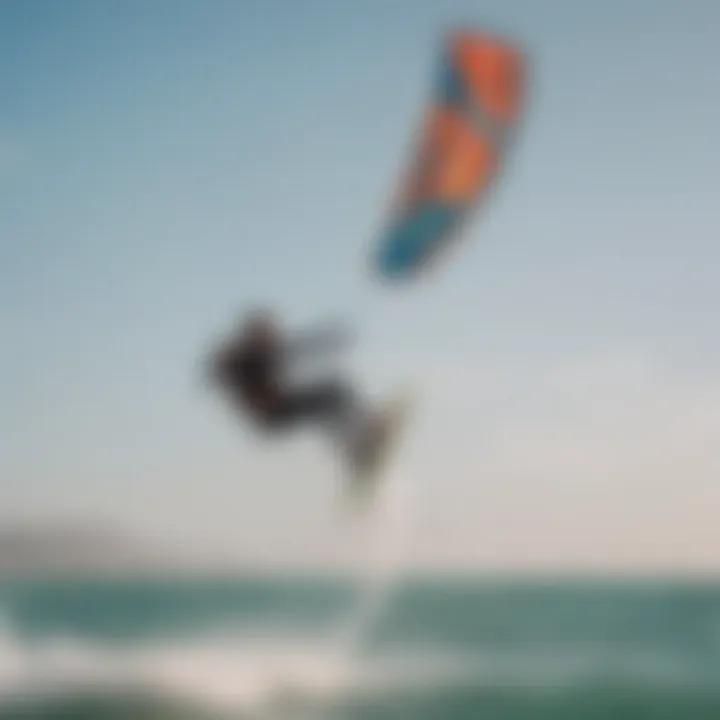
Intro
Kitesurfing is not just a sport; it’s a dance with nature, a fusion of wind, water, and skill that offers exhilaration like no other. For those looking to embrace this thrilling endeavor, kiteschools are the gateways to mastering the art of kitesurfing. These institutions go beyond mere lessons and provide a comprehensive environment for learning, making them essential for anyone keen on exploring this dynamic sport.
From understanding essential equipment to grasping techniques that tip the scales from novice to proficient, this guide delves deep. We’ll chart the course through the realms of kitesurfing, providing insights into kites, boards, and accessories, while also highlighting the destinations where the waves beckon. Alongside these practical tips and instructional content, safety measures will be stressed to ensure a safe and enjoyable experience.
Whether you’re considering taking that first leap into kitesurfing or are an experienced rider looking to refine your skills, this guide aims to equip you with the knowledge to navigate the colorful world of kiteschools effectively. Buckle in, and let this adventure on the winds begin!
Equipment Reviews
Diving headfirst into kitesurfing, your equipment choices can make all the difference between a smooth ride and a bumpy learning journey. Let’s break it down piece by piece, beginning with kites.
Kites
Selecting the right kite can feel a bit like hunting for the perfect pair of shoes—there are so many styles, features, and sizes to consider. Modern kites vary significantly in design and function, catering to different conditions and riding styles. Here are some critical aspects to consider:
- Shapes: The shape of a kite affects its performance. C-shaped kites, for instance, are excellent for freestyle maneuvers, while delta kites are known for their stability and ease of use, great for beginners.
- Sizes: Kite sizes usually range from 5 to 18 square meters. A smaller kite offers less power, ideal for stronger winds, whereas a bigger kite can catch more wind, perfect for lighter conditions.
- Materials: The material used, typically a mix of nylon and polyester, impacts durability and weight. Lightweight materials enhance maneuverability, but may not withstand harsh conditions.
When considering brands, well-regarded options include North Kiteboarding and Duotone, known for their innovation and quality. Each model comes with its unique features tailored to different conditions and riders’ abilities.
Boards
The next essential piece of gear is your board. Picture it like your own surfboard, but designed specifically for the kitesurfing experience. There are generally two types of boards:
- Twintip Boards: These are symmetric and can be ridden in both directions. They’re often recommended for beginners, as they allow easy recovery and riding versatility.
- Directional Boards: Designed for wave riding and often resemble surfboards, these are meant for more experienced riders looking to maximize their performance in specific conditions.Consider the construction quality. Many boards utilize lightweight foam, fiberglass, or carbon layers to enhance performance while maintaining durability.
Accessories
Accessories are the cherry on top of your kitesurfing gear. Here’s a quick overview:
- Harnesses: A good harness distributes pressure evenly and provides comfort during rides. You’ll see seat harnesses and waist harnesses; each has its pros and cons depending on your riding style.
- Lines: Ensure you have quality lines as they connect your kite to the control bar. Strong lines prevent breakage and control issues during your session.
- Pumps: A reliable pump is crucial for inflating your kite quickly. Look for a high-volume pump that can save you time and effort on the beach.
- Safety Gear: Helmets and impact vests may not seem essential, but they can make a significant difference in protecting you from falls and impacts. Always prioritize safety.
Remember,, investing in quality equipment might be costlier initially, but it pays off in performance, safety, and overall enjoyment.
"The best gear doesn’t make you a better rider, but it certainly makes the learning journey smoother and more enjoyable."
In this arena, informed choices are what set the successful apart from the disappointed. This synthesis of gear knowledge will guide you for making sound decisions before you hit the waves.
Understanding Kitesurfing and Kiteboarding
Kitesurfing and kiteboarding have gained substantial popularity over the years as thrilling water sports that combine elements of surfing, wind, and aerial maneuvers. This section serves as a keystone to the overall journey into the world of kiteschooling, accentuating the fundamentals that every novice must grasp before embarking on their kitesurfing adventure. The essence of understanding these sports is not merely about glossing over definitions but diving into the heart of what makes them an art in action. Comprehending the principles of kitesurfing involves recognizing the interplay between technique, equipment, and environmental factors, which collectively enhance the learning process.
Defining the Sports
Kitesurfing typically refers to a sport where individuals ride on a board while being propelled by a large kite. The kite is controlled by the rider using lines connected to a harness, allowing for various maneuvers including jumps, turns, and tricks. On the other hand, kiteboarding is often used interchangeably with kitesurfing; however, some enthusiasts differentiate the two based on board types—kiteboarding may suggest a more freestyle style, while kitesurfing encompasses wave riding and different terrain. Regardless of the terminology used, the underlying goal remains the same: to ride the wind and water with skill and grace.
Historical Context
The roots of kitesurfing can be traced back to the late 1970s and early 1980s, when pioneers experimented with using kites as a propulsion system. One of the earliest commercial adaptations of this concept happened with the advent of the Wipika Kite in 1992, which transformed how enthusiasts experienced the sport. As innovations continued to emerge—from the development of the inflatable kite to improved safety features—kitesurfing evolved into a mainstream activity across various beaches worldwide. Historically, this sport has attracted a dedicated community, from casual beachgoers to extreme athletes, all drawn by the exhilarating rush of harnessing wind power. As kitesurfing progresses, schools have popped up globally, offering structured lessons and fueling the growth of a diverse kitesurfing community.
The rapid evolution of kitesurfing equipment and techniques has allowed many to grasp and improve their skills, enabling a broader participation in the sport.
In understanding kitesurfing and kiteboarding, one isn’t just diving into physical activity; they are uncovering a lifestyle intertwined with nature, technique, and, importantly, a community that fosters shared experiences and adventures.
The Role of Kiteschools
Kiteschools play a pivotal role in shaping novices into skilled kitesurfers. Unlike the free-for-all that can sometimes characterize self-taught attempts, these institutions offer structured guidance to those keen on pursuing this exhilarating sport. The experience gained in a kiteschool can be the difference between a lifelong passion and an abandoned hobby. From comprehensive safety measures to expert instruction, kiteschools are the linchpin in the kitesurfing journey.
Understanding the significance of kiteschools necessitates a closer inspection of the benefits they offer.
Importance of Professional Instruction
When teaching someone to kitesurf, professional instruction is paramount. The power of the wind and the unpredictability of water present serious risks. Engaging with professionals who have accumulated notable experience can ensure that newcomers develop a strong foundation. Certified instructors provide guidance tailored to individual skill levels, ensuring that each student receives the attention they need.
A typical instructional approach will combine theoretical lessons with practical application. Students learn about wind patterns, tides, and equipment assembly before setting foot (or board) on the water. Plus, when under the watchful eye of a trained instructor, learners are less likely to pick up bad habits or incorrect techniques. This is an investment not just in skills but also in safety.
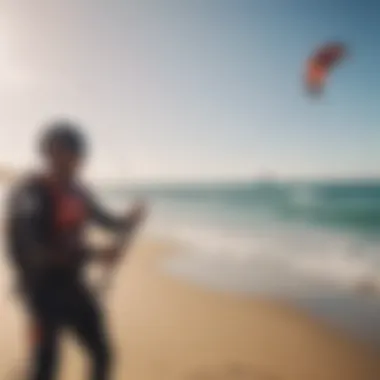
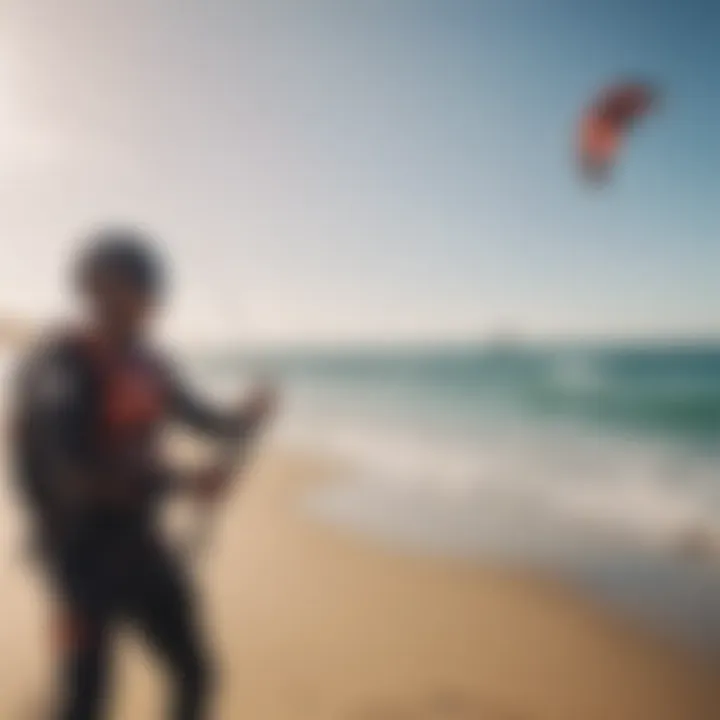
Moreover, professional instruction helps in building confidence. It’s not just about learning how to kite; it’s about nurturing a mindset that embraces challenges and cultivates resilience. Kitesurfing can be intimidating for some, but instructors provide encouragement and support, making it easier for individuals to overcome initial apprehensions.
"The gap between an enthusiast and a seasoned kiter is often measured in hours spent under expert instruction".
Overview of Kiteschool Methodologies
Kiteschools utilize a variety of methodologies to cater to different learning preferences, which can significantly enhance the educational experience. For instance, most schools adopt a "progressive learning" strategy. This implies that students start with the basics and gradually move to more advanced techniques as their skills develop. While it sounds straightforward, the execution plays a crucial role.
Common practices include:
- Hands-On Sessions: Many kiteschools employ a practical first approach. Students often begin their training on the beach, getting comfortable with handling the kite before hitting the waves.
- Video Analysis: Some institutions leverage technology, allowing students to review their performances in real time. This immediate feedback mechanism is invaluable for correcting mistakes and improving technique swiftly.
- One-on-One Coaching: Tailoring instruction to individual needs can yield excellent results. Smaller classes or private sessions allow for personalized feedback, making the learning experience more effective.
In essence, the methodologies employed by kiteschools are designed to ensure that the learning curve is manageable. By introducing techniques at an appropriate pace, schools create a supportive environment that encourages progression while mitigating the risks associated with this thrilling sport.
Types of Kiteschools
Understanding the various types of kiteschools is crucial for anyone looking to get into kitesurfing. The approach to learning can differ significantly between local and destination schools, as well as mobile kiteschools that roam from one spot to another. Each type offers distinct advantages and considerations that can affect both the learning process and overall experience.
Local vs. Destination Kiteschools
Local kiteschools are often found in coastal areas where kitesurfing is prevalent. These schools cater to residents and those who live nearby, providing a convenient option for regular lessons. In contrast, destination kiteschools are typically located in renowned kitesurfing spots around the world.
Here’s what you should consider when choosing between them:
- Accessibility: Local kiteschools offer easy access to lessons, allowing for flexibility in scheduling, while destination schools usually require travel, which may not suit everyone.
- Cost: Local schools often provide competitive pricing due to less overhead, whereas destination schools may come with higher costs, reflecting the premium location.
- Experience Level: Destination kiteschools may offer specialized sessions for all skill levels, often right by beautiful beaches with perfect wind conditions.
- Community: Local kiteschools foster tight-knit communities where you can meet fellow kitesurfers, although destination schools can introduce you to a more diverse group of enthusiasts from various cultural backgrounds.
"The learning curve can vary significantly, and location impacts not just the skill enhancement, but also the overall enjoyment of the sport."
Mobile Kiteschools and Their Advantages
Mobile kiteschools take a unique approach by traveling to different locations, enabling them to adapt their teaching to varying conditions. Their benefits are numerous:
- Variety of Locations: These schools allow students to experience different kitesurfing spots, suited to varying weather patterns and sea conditions.
- Personalized Learning: As the instructor chooses specific locations based on students’ needs, this tailor-made approach can lead to quicker skill progression.
- Adventure and Discovery: Kitesurfing at different beaches creates a sense of adventure. It’s not just about the lessons; it’s about the journey and exploration of new environments.
While mobile kiteschools may have unpredictable schedules and could come with their own sets of logistical challenges, for some, the element of travel and discovery is what makes the experience truly unforgettable.
Choosing the Right Kiteschool
Selecting the right kiteschool can often feel like finding a needle in a haystack, especially for newcomers drawn to the thrilling world of kitesurfing. It's not just about finding the nearest place with a kite and a board; this decision plays a crucial role in shaping the overall experience and understanding of the sport. With numerous options, understanding the elements that distinguish one school from another is vital.
Choosing the right kiteschool means considering the school's reputation, the qualifications of the instructors, and even the specific teaching methods employed. A kiteschool’s environment, student-to-instructor ratio, and feedback from past students can reveal a lot about the quality of the instruction.
Further, it’s about your comfort and personal preference. Do you prefer a relaxed atmosphere or a more rigorous training approach? Each of these factors contributes to not just learning kitesurfing but also enjoying the journey.
"The right teacher can make a world of difference; it’s not just about learning to ride the waves, it’s about enjoying every gust of wind."
Factors to Consider
When choosing a kiteschool, there are several factors to keep in mind:
- Location: Proximity is key. A nearby school saves time and travel hassles. However, if the destination school is famed for its expert instructors or unique conditions, a bit of travel might be worth it.
- Reputation: A school’s reputation can often be assessed through reviews on platforms like Facebook or Reddit. Checking forums can provide insights from actual students about their experiences.
- Instructors’ Experience: It's important to learn from those who not only have extensive experience in kitesurfing but also in teaching others. Look for schools with certified instructors who prioritize safety and communication.
- Equipment Quality: Kiteboarding requires specific gear that can impact your learning curve. Schools that maintain high-quality and well-maintained equipment reflect professionalism standards.
- Class Size: Smaller classes generally mean more personalized attention. Schools that offer a good instructor-to-student ratio could enhance the learning experience.
Considering these elements can guide you toward finding a kiteschool that aligns best with your learning preferences.
Evaluating Instructor Qualifications
To maximize your kitesurfing learning experience, understanding instructor qualifications becomes essential. The best instructors combine practical skills with teaching abilities.
Start by exploring the instructors’ backgrounds. Look for certifications from recognized institutions like the International Kiteboarding Organization, as these certifications typically ensure a certain level of expertise and adherence to safety standards. Instructors with a passion for their craft often translate their enthusiasm into effective teaching.
Here’s what to examine:
- Certifications: Check if the instructors hold valid certifications in teaching kitesurfing. This can provide peace of mind knowing that you’re learning from someone recognized in the field.
- Experience Level: Experienced instructors can provide valuable insights and tips that a beginner might not consider. Instructors with years of teaching experience are usually more adept at identifying and correcting mistakes early on.
- Teaching Approaches: Not all instructors teach the same way. Some might use more technical jargon while others may prefer a hands-on approach. Ensure their teaching style aligns with how you learn best.
- Communication Skills: The ability to communicate effectively is crucial in a teaching setting. Nonetheless, how an instructor explains concepts can make a significant difference in comprehension.
Curriculum and Training Approaches
Understanding the curriculum and training approaches employed by kiteschools is foundational for anyone stepping into the world of kitesurfing. Programs need to strike a balance between offering comprehensive skills knowledge and allowing for individual progression. An effective curriculum will help students grow, turning absolute novices into competent kitesurfers while ensuring safety and enjoyment are paramount.
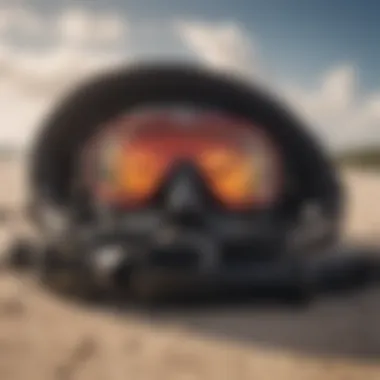
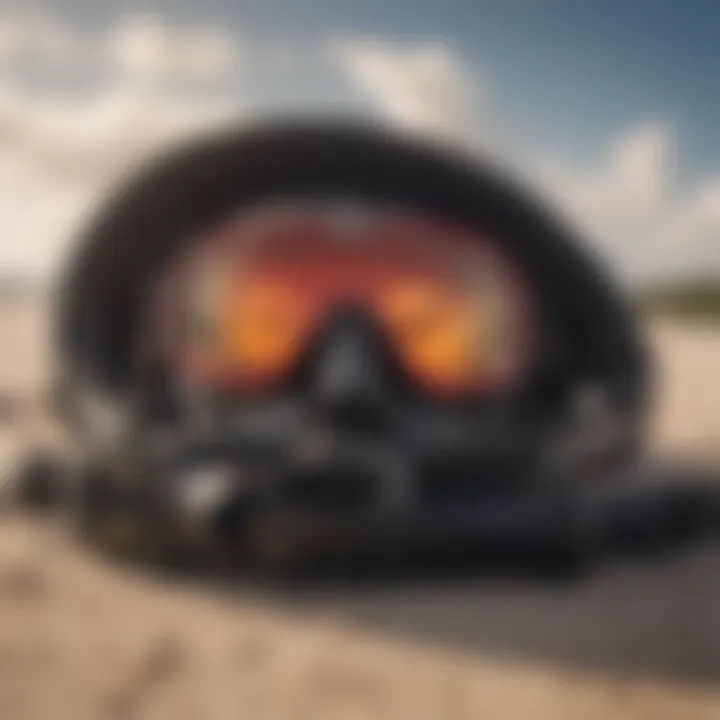
Basic Skills and Techniques
In the initial stages of kitesurfing, grasping the basic skills and techniques is crucial. This lays the groundwork for a successful riding experience. Typically, students will start by familiarizing themselves with kite control. This involves learning how to properly handle the kite while on land, understanding its movements in relation to the wind, and mastering the use of the control bar.
From there, the focus shifts to water starts. Students practice body dragging, a technique where they learn to control the kite while being pulled through the water. This builds confidence and gathers practical experience before attempting to stand on the board. The transition from a body drag to water starts is delicate, as one must learn to manage the kite even more finely while balancing on a board as it glides over waves.
Additionally, instructors emphasize safety awareness. New kitesurfers gain insights into avoiding hazards, recognizing conditions that might indicate bad weather, and understanding how to signal for help should it be necessary. It's not just about learning to ride; it’s about ensuring one can ride safely.
"The best time to learn is when you're completely aware of what to do and the possible risks involved. Safety first!"
Progressing to Advanced Techniques
Once students have a firm grasp of the basics, it’s time to elevate their skills to more advanced levels. This part of the curriculum often includes learning jumping techniques, transitions, and riding in different conditions. Understanding how to interpret wind patterns can significantly enhance a kitesurfer’s ability to maneuver effectively.
Jumping, for instance, relies on a solid technique of kite control and timing. Instructors will often break down the components: edge control, power transfer to the board, and the optimal moment to pull on the bar to gain lift. Progressing into this realm can be exhilarating, as students witness their own growth.
In addition to jumps, kitesurfers are taught about tricks that can turn novice-level board riding into a thrilling spectacle. This includes spins, flips, and even using the waves for some extra fun. However, each of these techniques requires deep practice and patience.
Here, the emphasis again returns to safety. Riders learn the importance of evaluating their surroundings before attempting advanced maneuvers, ensuring they understand currents, the presence of other surfers, and other environmental factors.
Overall, a solid curriculum and approach to training in kiteschools create a pathway not just for learning techniques, but for cultivating a responsible and skilled kitesurfing community.
Essential Equipment for Beginners
When stepping into the exhilarating world of kitesurfing, having the right equipment is downright crucial. Not only does it ensure safety, but it also allows beginners to learn effectively and enjoyably. In this section, we’ll break down the foundational tools of the trade, focusing on kites, boards, safety gear, and accessories.
Kites and Boards: A Primer
Selecting the right kite is paramount for any novice kitesurfer. Kites are classified into various types, and each serves a unique purpose.
- Size Matters: The size of the kite plays a significant role in determining how well a beginner can control it. Larger kites catch more wind and can lift you off the water more easily, yet they can also be more challenging to handle. Newbies often find kites around 10 to 12 square meters most manageable.
- Types of Kites: Generally, kites fall into three categories:
- Foil Kites: Designed for efficiency in light winds, these kites are easy to relaunch and handle.
- LEI (Leading Edge Inflatable) Kites: These are the most common for beginners due to their durability and forgiving nature. They handle gusts and are easier to control
- Delta and Hybrid Kites: Offering versatility, they perform well in varying conditions and are often suitable for beginners seeking to progress in their skills.
When it comes to boards, understanding your personal needs is critical. Boards come in various shapes and sizes, including twin tips and directional boards. Twin tips, which can be ridden in either direction, tend to be ideal for beginners.
- Typical Length: Newcomers should look for boards that are around 130 to 140 cm long, as this size offers a good balance between stability and maneuverability.
- Material: Most beginner boards are constructed from durable materials that withstand the rough handling common in early lessons.
In summary, having the right kite and board combination not only facilitates better learning but also instills confidence, allowing novices to focus on honing their skills rather than struggling with inadequate equipment.
Safety Gear and Accessories
It's no secret that safety is the name of the game when it comes to kitesurfing. A miscalculation can lead to dire consequences, making it essential for beginners to gear up adequately.
- Harness: Selecting the right harness is crucial since it connects you to the kite. There are waist and seat harnesses to choose from, with waist harnesses popular among beginners for their ease of use and comfort.
- Helmet: A sturdy helmet will protect the head from any unexpected falls or collisions, especially in crowded spots. Opt for one specifically designed for kitesurfing to ensure a snug fit and impact protection.
- Impact Vest: Equally important is an impact vest, which not only provides additional buoyancy but also protects the ribs and back during falls. Ensure the vest fits tightly to avoid discomfort while moving.
- Floatable Waistbelt: These add extra safety by providing buoyancy, especially when starting out in unfamiliar waters.
- Bar and Lines: A quality control bar and line system allows the kiter to steer the kite efficiently. A line length of around 18 meters is often recommended for beginners since it allows for better control.
In addition to these essentials, sunscreen is a must-have, as prolonged exposure to the sun while kitesurfing can lead to serious burns.
"The right equipment can be the difference between a thrilling experience and a troublesome one."
This equipment not only paves the way for a safer experience but also enhances the overall joy of learning this dynamic sport. Being properly outfitted will allow beginners to focus on technique and progression instead of worrying about safety mishaps. Thus, investing in quality gear is a crucial step for any new kitesurfer.
Safety Considerations in Kitesurfing
Kitesurfing is as thrilling as it is demanding, and with great excitement comes great responsibility. Understanding safety in kitesurfing is paramount for both new and experienced riders. When you’re out on the water, the unpredictable nature of the environment can be daunting. Quite frankly, safety considerations should never take a back seat. Fostering a safety-first mindset helps in avoiding accidents and ensures a fun experience.
Understanding Weather Conditions
Weather can make or break your kitesurfing experience. The wind, waves, and overall climate should dictate your kiteboarding decisions. If you think, "Oh, a little wind won't hurt," then you could be inviting trouble. Properly gauging conditions can determine whether you’ll be catching air or swimming back to shore drenched and frustrated.
- Wind Strength: Ideally, you should aim for stable winds between 12 to 25 knots for beginner sessions. Too little wind can leave you stuck, while too much can be overwhelming, even for experienced riders.
- Wind Direction: Always consider where the wind is coming from. Onshore winds may push you back to the shore, while offshore winds could blow you far into the water. You don’t want to find yourself in a sticky situation, paddling back against the current.
- Tides and Currents: Not all beaches are created equal. Some may experience strong tidal flows that can sweep you further away from your target. Knowing your local waters can keep you in the sweet spot, avoiding both danger and embarrassment.
- Weather Changes: Summer showers don’t just come with rain; they can bring unpredictable wind shifts. Always check forecasts regularly before going out. If a storm is brewing, it’s better to postpone that session.
"There’s no telling what weather will throw at you, so keep an eye out!"
Injury Prevention Techniques


Just like in any sport, injuries are part of the game. However, with a few precautionary measures, you can minimize those bumps and scrapes. It's about preparing for the unexpected, because you never know when a wave might catch you off guard.
- Physical Preparation: Getting fit is essential. Building strength and flexibility help prevent injuries. Consider activities like yoga or swimming to enhance your overall conditioning.
- Warm-Up: Before hitting the water, spend about 15 minutes stretching. This helps in warming your muscles and preventing strains. Simple leg stretches or arm rotations can make a significant difference.
- Safety Gear: Wearing a personal flotation device (PFD) may seem like a no-brainer, but some riders overlook it. It can save your life. Don’t skimp on a helmet or impact vest either.
- Kite Control: Mastering your kite's control is important. The more you practice, the less you'll panic in tricky situations. Understanding how to quickly depower your kite is an essential skill that every kitesurfer should wield.
- Buddy System: Whenever possible, ride with friends. Not only is it more enjoyable, but having someone nearby can be the safety net you need during an unexpected mishap.
These considerations in kitesurfing may not sound glamorous, but they lay the groundwork for enjoyable sessions on the water. Stay informed, stay safe, and you’ll be well on your way to mastering the art of kitesurfing.
Kitesurfing Destinations and Travel
Kitesurfing is more than just a sport; it's a lifestyle that often leads enthusiasts to some of the world's most breathtaking locations. The significance of identifying the right kitesurfing destinations cannot be understated. The allure of the ocean, the thrill of harnessing the wind, and the camaraderie formed with fellow kitesurfers enhance the overall experience.
Additionally, the variety in landscapes, water conditions, and local cultures can greatly influence one’s learning and enjoyment of the sport. Regions known for kitesurfing typically offer consistent wind conditions, ensuring that travels do not go to waste. Having a clear understanding of what these destinations have to offer helps kitesurfers make smarter choices in planning their adventures.
Popular Kitesurfing Locations Globally
Selecting a destination can be an overwhelming task, given the plethora of options worldwide. Here is a list of notable kitesurfing spots that consistently attract beginners and pros alike:
- Cabarete, Dominican Republic: Known for consistent trade winds and a vibrant local scene.
- Tarifa, Spain: The wind capital of Europe, with a laid-back atmosphere and numerous kite-friendly beaches.
- Maui, Hawaii: Offers diverse conditions suitable for every skill level; a true paradise for kitesurfers.
- El Gouna, Egypt: Perfect flat waters thanks to the protective lagoons, ideal for learning and practicing tricks.
- Bonaire, Caribbean: Renowned for warm waters and steady winds, a favorite among long-term travelers.
These locations are not just beautiful; they also offer infrastructure that caters to kitesurfers, including schools, rental shops, and welcoming communities.
Travel Tips for Kitesurfing Enthusiasts
Traveling with gear can be a hassle, but with some preparation, you can make your journey smoother. Here are some tips for kitesurfing enthusiasts heading out on an adventure:
- Pack Efficiently: Prioritize space by using travel bags specifically designed for kitesurfing gear. Also, check airline policies on sports equipment to avoid unexpected fees.
- Research Local Conditions: Each destination has its peak seasons. Familiarize yourself with local weather patterns to maximize your time on the water. For instance, Tarifa’s strong winds typically peak in the summer months.
- Stay Connected: Engage with local kitesurfing communities before you arrive. This could be through social media platforms such as Facebook and Reddit. They can provide valuable insights on spot conditions, equipment rentals, and the best schools to contact.
"The best part of kitesurfing is not just the ride, but the friends you make and the stories you'll tell."
- Safety First: Always check for safety advisories related to wildlife or water conditions in unfamiliar areas. Knowledge about currents and tides can prevent mishaps and enhance your enjoyment.
- Try Local Cuisine: Don't miss out on regional specialties. Local dishes can be an integral part of the cultural experience, and sharing food with other kitesurfers can foster camaraderie.
In summary, diving into the kitesurfing world not only involves learning to ride the wind but also choosing the right destinations that fit your style and skill level. With the proper planning and knowledge, your kitesurfing trips can be as exhilarating and rewarding as the sport itself.
The Kitesurfing Community
The kitesurfing community is more than just a group of enthusiasts who share a love for the water and wind. It embodies a network of support, camaraderie, and shared experiences that can enhance one’s journey in kitesurfing. Engaging with this community can enrich an individual’s learning curve and create lasting friendships that transcend geographical boundaries. Whether you’re hitting the local beach or participating in global events, the community connection is pivotal in fostering growth and enthusiasm about the sport.
Networking with Other Kitesurfers
Networking within the kitesurfing community isn’t limited to just making friends; it's about sharing knowledge, techniques, and experiences. When you connect with seasoned kitesurfers, you tap into a wealth of information that can guide your practice and performance.
- Skill Development: Meeting other kitesurfers can introduce you to unique techniques that you might not learn in a formal class. Some enthusiasts may have their own approaches to tricks, safety, and equipment usage, which can be immensely helpful.
- Mentorship: Longer-standing members often take on the role of mentors for newbies. Their willingness to share insights and critique can be priceless.
- Social Events: Many communities host meet-ups or fun surf days, providing an informal setting to learn while you also socialize.
Engagements on platforms such as reddit.com or local Facebook groups can also reveal possible collaborations and enhance your overall kiting experience. This interaction is pivotal for building connections and gaining new friends who share the same passion.
Events and Competitions
Events and competitions act as a celebration of the sport, bringing together kitesurfers from all walks of life. Participating in or simply attending these events not only fuels the passion for kitesurfing but also expands your awareness about the global kitesurfing scene.
- Competitions: Events range from local contests to world championships. They offer participants a platform to showcase their skills and receive feedback from professionals. For many, it’s a chance to turn informal practice into a recognized challenge. Competitions can also spark motivation; watching elite kitesurfers can inspire newcomers to hone their skills.
- Meet and Greet: These gatherings serve as fantastic networking opportunities, allowing participants to share their experiences, gear preferences, and personal stories. You learn from each other, which aids progression.
- Community Building: Regular events can solidify a sense of belonging within the kitesurfing community. It cultivates friendships and encourages newcomers to dive deeper into the sport.
Engaging in events not only provides a chance to compete or watch but also fosters a deeper connection with the sport and its practitioners. It creates an ecosystem, benefitting both experienced riders and those merely getting their feet wet in the world of kitesurfing.
Future Trends in Kitesurfing and Kiteschools
The landscape of kitesurfing and kiteschools is evolving faster than a seasoned rider on a wind-blown tide. As the sport continues to grow in popularity, several trends are beginning to take shape that could significantly influence how kitesurfing is taught and experienced. These future trends point to a combination of technological advancements and a growing awareness of environmental impacts. Enthusiasts and instructors alike will benefit from understanding these shifts as they navigate this dynamic field.
Technological Innovations
With the relentless thrust of technology, kitesurfing is witnessing innovations that streamline learning and enhance safety measures. One of the most notable advancements is the integration of smart technology into gear. Companies are now designing kites equipped with sensors that relay real-time data about wind speed, kite angle, and altitude directly to a smartphone app. This kind of feedback can drastically improve the learning curve for beginners by providing insights into their performance and making adjustments on the fly possible.
Furthermore, virtual reality (VR) training tools are emerging as another trend in kiteschools. These tools allow aspiring kitesurfers to practice their skills in a simulated environment before hitting the waves. This approach not only reduces anxiety on the water but also enables users to visualize their movements accurately. As these technologies become more affordable, we may see kiteschools incorporating them into their programs to better prepare students before they ever touch the water.
Another prominent advancement is the rise of electric foils, which make it easier for riders to glide across the water with less wind required. This democratizes the sport and makes it accessible to a broader audience, including those in areas where winds are less predictable. It’s a significant change that can alter where kitesurfing can be practiced successfully, and schools may adapt their curricula to include these new opportunities.
Environmental Considerations
In recent years, a growing commitment to sustainability within the kitesurfing community has become apparent. Kiteschools now find themselves at the crossroads of instruction and environmental stewardship. Trends indicate a shift towards eco-friendly practices and materials, which provide not only ethical benefits but also deepen the connection between kitesurfers and the environments they enjoy.
Many brands are innovating by producing kites and boards from sustainable materials. This shift is not just about reducing plastic waste; it's a movement to ensure that the beautiful beaches and marine environments remain intact for future generations. Reflecting this consciousness, kiteschools are beginning to educate students about the impact of ocean pollution and climate change on our water sports. They often incorporate talks and workshops that aim to inspire a sense of responsibility among their students.
Moreover, eco-tourism is catching traction among kitesurfing enthusiasts. Schools are now often located in pristine, yet vulnerable areas which rely heavily on tourism. Initiatives that promote conservation while enjoying the sport have started gaining popularity, and kitesurfers are making efforts to engage in beach clean-ups and habitat restoration projects. This dual commitment reinforces the concept that joy in kitesurfing goes hand-in-hand with respect for nature.
"As kitesurfers, we ride the wind and water, and it's our responsibility to ensure we ride into a sustainable future."







